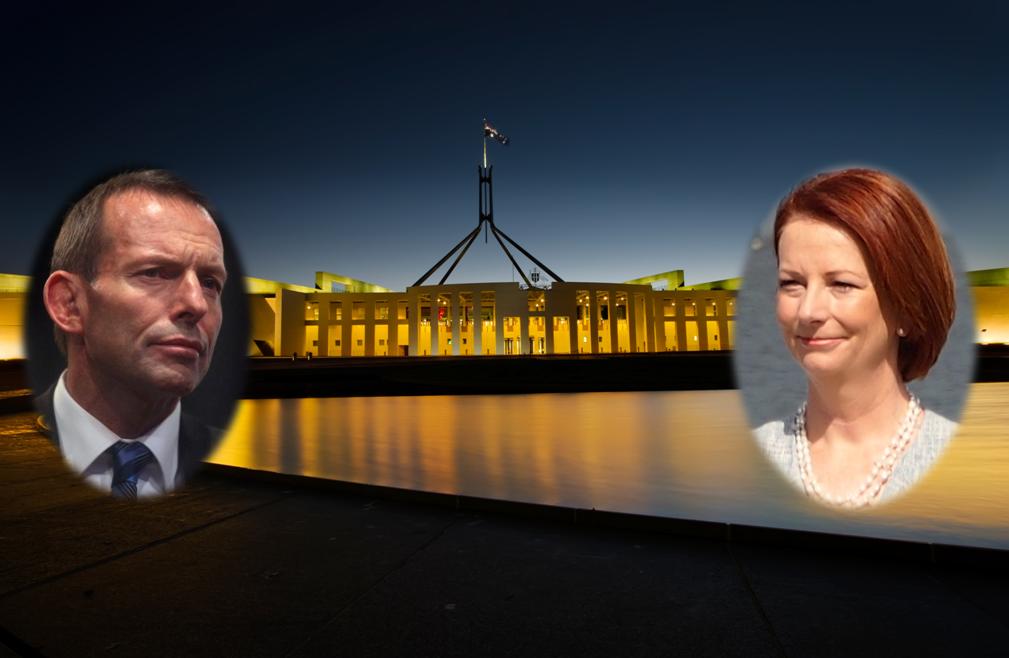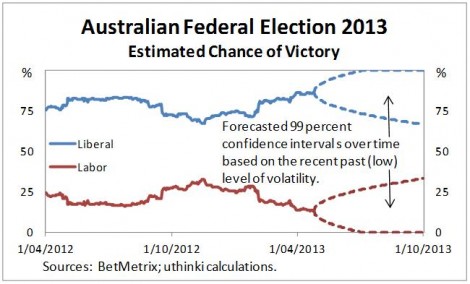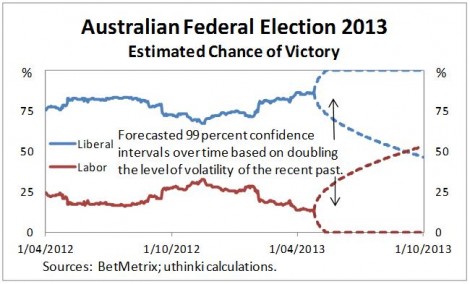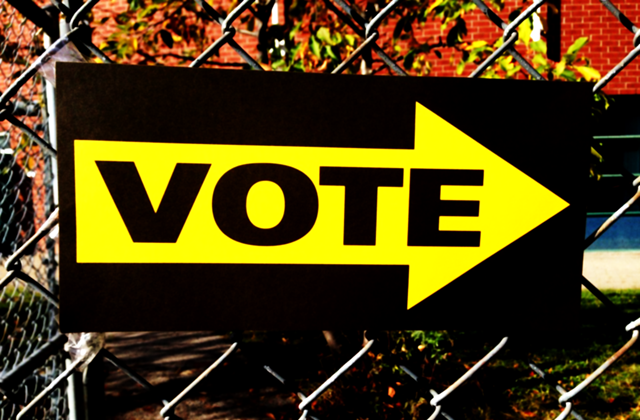Ask Not for Whom the Poll Falls, it Falls for Thee
With the Australian federal election still approximately five months away, it may be time to take stock and consider what may be ahead as the campaign trail starts to ramp up.
At the time of writing, the polls for the Julia Gillard led Australian Labor Party (ALP) imply a near 13 percent chance of winning the September 2013 Australian federal election; whilst for the Tony Abbott led Liberal Party (representing the overall Coalition including the Nationals) the implied chance of winning is approximately 87 percent.
For up-to-date information on the Australian federal election 2013 polls see BetMetrix.
As was considered in the earlier post related to the ALP leadership spill, the dominant strategy for Kevin Rudd or any other potential challenger and would-be alternate leader of the Labor Party, was, and is, simply to remain silent and wait until after the election. This is because, as above, based on the current polls under Julia Gillard’s leadership, Labor is highly likely to lose the September 2013 federal election. Whilst it also made sense for Prime Minister Julia Gillard to hold onto power however she could, for however long she can.
Political Power for We the People?
If one ascribes to the notion that politicians will do what (and even possibly whatever) they can to gain and maintain power, then what follows should hold an element of the logical course of potential future events.
If on the other hand, one holds onto the more altruistic notion of a politician doing what is in the best interests of the people, there may be an element of naïvety here. That is not to say this cannot happen. It depends on the nature of the political system (spanning from autocracy to complete democracy), it’s alignment, and how broad is the base of those holding the true voting power (insiders versus the general public). However, there is also the need to be somewhat careful of altruistic notions. Especially in politics. Asking some to give up or sacrifice something for the good of others, is all too easily and readily twisted into that benefitting the state and more importantly those in a position of power controlling it.
Simple Game Theory
With the current situation in Australian federal politics, there are two examples from game theory worth considering first for a sense of strategy.
Were it a simple gambling situation amongst two parties, then provided that the party with the lowest amount of capital has to move first and disclose their choice, then the dominant strategy for the other party with greatest amount of capital is to copy exactly what the other has done.
Another relevant example of a simple game, would be a race. With the superior party in front, then the dominant strategy for the party in second place is to copy exactly what the one in first place is doing. Given the lead, it’s therefore improbable that the party in second place can ever win. Although it does increase the probability of maintaining second place and not slipping back further into third place or worse.
However, the real world is not quite such a simple game. Nor is the situation in Australian politics with the ALP and the Liberal Party exactly the same. Yet some insight can be found from the above two examples, and they can also be extended into something more applicable. Like it or not, the Australian federal election is essentially a two party race between Labor and Liberal, and it is largely a gamble. Given the situation, it is somewhat contradictory as the strategies tend to favour the rather circuitous case of both political parties trying to copy and second guess one another. It should therefore not come as a surprise that their policies are rather similar.
Although the odds may favour a win for the Coalition, there is also potential impact on Australia in either case. Neither the PM Julia Gillard nor the opposition leader Tony Abbott are held in high regards by many Australians.
Voters are Somewhere Between the Floor and the Ceiling
Before moving on, consider reputation effects and volatility.
If one has established a good reputation and holds a position of power, the dominant strategy is not to make any bold claims. Similarly should they have to make a forecast, it’s best to toe the line, and be in line with the consensus of expectations. This serves to preserve the favourable reputation, and lower the risk of losing it. This could be considered as a low volatility strategy.
If one has no or a low established reputation and does not hold a position of power, it can make strategic sense to make bold claims and forecasts. Should these prove correct they serve to elevate the status; and if they are incorrect then there’s little left to lose.
Therefore, a low volatility strategy, will necessarily have less dispersion amongst the probability paths taken over time. Conversely, a high volatility strategy will necessarily have greater dispersion amongst the probability paths taken with respect to time.
Consider then, this with respect to how Labor and Liberal may act regarding their future policies and campaign strategies. Obviously, in terms of dispersion, it will not just be pure randomness; and the attempts by both parties will be to direct the overall average path towards the greatest chance of winning.
Additionally, in terms of getting elected (or re-elected) there is necessarily a ceiling effect at the 100 percent chance of winning, and a corresponding floor effect at the zero percent chance of winning.
As can be seen in the diagram immediately below, a low volatility strategy favours the election of the Liberals in the Australian federal election in September 2013.
Alternatively, as is shown in the next diagram, a high volatility strategy instead favours an increased chance (subject to the level of overall volatility) of Labor managing to be re-elected in the Australian federal election in September 2013.
Voting Options Framework
Focusing on only the two major Australian political parties, the ALP and the Liberals, allows for further analysis with respect to volatility and how it may impact on either party winning the election.
Because of the probabilities of assuming only the two parties, as a binary outcome then one of the parties must have a probability of winning of p and the other party must have a probability of winning of 1 – p. Where the total probability equals one, hence: 1 = p + (1 – p)
In this case both political parties will be vying to control the total level of volatility, because this must necessarily impact the other party and the respective probabilities of each party winning the federal election.
Labor will likely seek to increase the volatility to increase its probability of winning; this must come at the expense of the Liberal Party’s probability of winning. As a corollary, the Liberals will likely seek to suppress any volatility to maintain their already high probability of winning.
This can also be considered using the framework of finance with the perspective of real options. The Liberals currently have an in-the-money (ITM) option and given they’re near the ceiling for winning, increasing volatility lowers the probability of victory and increases the probability of defeat. The Australian Labor Party on the other hand, have an out-of-the-money (OTM) option and given they’re near the floor for losing, increasing the volatility raises the probability of victory. Hence in terms of winning the September 2013 election increasing volatility is more likely to result in the ALP’s option moving favourably from OTM to ITM and the Liberals’ option moving unfavourably from ITM to OTM.
Again the notions of one party’s actions being at the expense of the other are clear in this binary framework.
From Volatility to Policy
Whilst Julia Gillard and the ALP currently hold the position of power and hence have more to lose (than the opposition), it does appear that they will lose. Although five months can be a long time in politics. On the basis of the polls, the ALP is closer to the floor for re-election (thereby losing), whilst the Liberals are closer to the ceiling for election (thereby winning).
On this basis, volatility will be likely upped by policies the ALP believes will increase its probability of winning the 2013 election. As such it’s more likely to make bolder promises (which can always be broken if re-elected; feel free to debate the semantics of a carbon tax versus a carbon emissions trading scheme, ETS, in the comments below) and propose sweeping policies and reforms, such as the proposed Gonski education reforms.
There is also more likely to be muckraking and mudslinging from the ALP directed at the Liberals, especially over the latter’s apparent lack of policy direction. A dirtier election campaign may reasonably be expected from Labor. Provided that the polls continue to favour the Liberals, then they are likely to run a cleaner campaign, and play the card of riding the high horse of not being drawn into dirty politics. Here they are also likely to point out the recent and continuing internal disarray of the ALP; compared to their apparent solidarity within the Liberal Party.
Recent examples of this would include:
Julia Gillard calling Tony Abbott an “economic simpleton“.
Tony Abbott stating that “People should be polite to the Prime Minister“.
In contrast to the ALP, the Liberals on the other hand, are far more likely to take a steady as it goes approach. Their strategy, whilst still subject to party ideologies, will likely be a combination of: Not saying or disclosing too much at all with respect to their policies; this low volatility strategy keeps the probability paths from dispersing too much and predominantly above the required 50 percent chance of winning threshold. Most moves will be in reaction to Labor’s statements, because drawing on the two simple games mentioned earlier, if nothing happens (assuming the polls remain largely unchanged) and things continue on as they have been, then the Liberals effectively will win the Australian federal election by default . As the Liberals will likely let Labor move first, they will then mimic them albeit while also attempting to limit any real change to volatility (of viewpoints and in public opinion). An example of this would be the Coalition’s variant of the NBN rollout policy. Somewhat different, yet still rather similar.
This Time, Same-Sex Marriage is an Unlikely Election Issue
Gay or same-sex marriage has been a highly topical area of debate lately. Various elements of discrimination and inconsistencies within government policies in this regard were considered in a previous post. Recently the countries of New Zealand and France both have legalised same-sex marriages.
Whilst public opinion on same-sex marriage is changing (for example, see Nate Silver’s analysis and prediction here for The New York Times about it potentially being a Presidential election issue in the USA in 2016), it’s unlikely to be a raised as a federal election issue in Australia in 2013.
Reasons for this, are that not all of the gay community (often estimated to be about 10 percent of the overall population) are likely to realistically consider same-sex marriage an election issue. Similarly, neither will the rest of the community including many of the constituent voters for either of the two major Australian political parties. Although proposing government policy on legalising same-sex marriages is likely a high volatility strategy, it’s also one that is unlikely to increase the probability of actual realised votes overall for either major party. At the margin, it’s currently unlikely to decide the 2013 Australian federal election. The probabilities (at the time of writing) are too different for the estimated numbers of those supporting gay marriages to significantly influence the overall Australian federal election outcome in 2013.
This is because it’s more likely to offend those more conservative voters with respect to this matter (and such active voters are most likely currently in the majority). Resulting in them either choosing to vote elsewhere (for a minority party; potentially making it a matter of preferences and independents), or with an informal vote. Either way it would effectively be a protest to not vote for either of the two major parties (the ALP or the Coalition). Which does not help either win, and has likely been a consideration amongst the campaign strategies thus far.
That is not to say that it may not appear on the Australian federal election cards in the next five months in the lead up to September. It will be subject to sentiment and public opinion polls. However, legalising same-sex marriages would represent a major gambit politically for either Labor or Liberal. Given the current situation, and ideologies, if it were to become a 2013 election issue, the safe assumption would be that the ALP would be the major party to introduce it.
From Now Until the Election
Of course this is all around five months out from the election. So it remains to be seen exactly how it plays out because forecasts (especially about the future) are always difficult. A paraphrased statement that many have claimed; and it’s often attributed to Yogi Berra instead of correctly to Niels Bohr. Not everyone can be smarter than your average bear, or a Nobel Prize winning physicist.
The thing here is that the Australian federal election in September 2013 is still yet to be decided. Accordingly the public opinions and votes of the people must shape it, and they’re probably hesitant to have a repeat of the outcome of the 2010 election with no clear winner and another minority government formed. The Australian voters are likely to vote, for or against. Strongly. If the current opinion polls are to be believed. Political strategists will attempt to spin and exploit this however best they can.
In meantime how do you expect these political issues, and politics in general, to play out? And whilst you’re out playing, you can also attempt to outsmart the crowd as well.
Feature Image Credit: MystifyMe Concert Photography (Troy); Nick-D; Sam
 uthinki Considered Opinion?
uthinki Considered Opinion?





